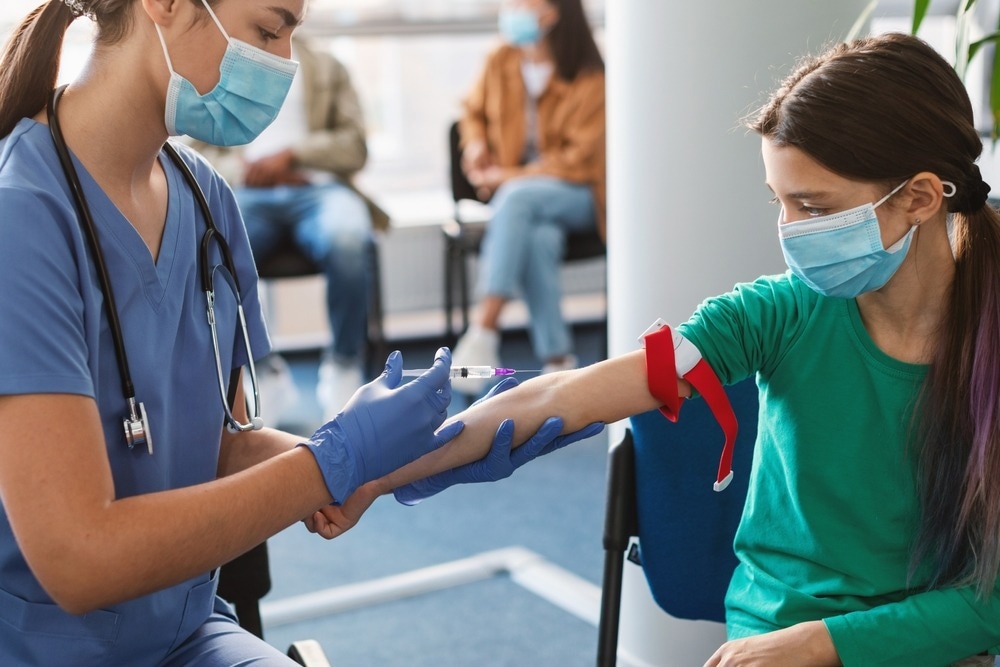In a recent study posted to the bioRxiv* server, researchers used a nearly real-time monitoring framework for early detection of potential safety signals following the administration of the BNT162b2 vaccine in over three million United States (US) children aged five to 17 years. They conducted this study under the US food and drug administration (FDA) biologics effectiveness and safety (BEST) initiative.
 Study: Results of safety monitoring of BNT162b2 (Pfizer-BioNTech) COVID-19 vaccine in U.S. children aged 5-17 years. Image Credit: Prostock-studio/Shutterstock
Study: Results of safety monitoring of BNT162b2 (Pfizer-BioNTech) COVID-19 vaccine in U.S. children aged 5-17 years. Image Credit: Prostock-studio/Shutterstock

 *Important notice: medRxiv publishes preliminary scientific reports that are not peer-reviewed and, therefore, should not be regarded as conclusive, guide clinical practice/health-related behavior, or treated as established information.
*Important notice: medRxiv publishes preliminary scientific reports that are not peer-reviewed and, therefore, should not be regarded as conclusive, guide clinical practice/health-related behavior, or treated as established information.
Background
In the US, the coronavirus disease 2019 (COVID-19) BNT162b2 vaccine was the first approved vaccine for the pediatric population, age band six months to 17 years. Other approved vaccines are messenger ribonucleic acid (mRNA)-1273 and NVX-CoV2373, approved for ages six months to 17 years and 12 to 17 years, respectively. Post-authorization monitoring of severe acute respiratory syndrome coronavirus-2 (SARS-CoV-2) vaccines is crucial to ensure their safe use in children.
About the study
In the present study, researchers used administrative claims data from three sources, viz., Optum, HealthCore, and CVS Health. These sources had BNT162b2 vaccination data stratified by age group through June 25, 2022, June 6, 2022, and June 31, 2022, from Optum, HealthCore, and CVS Health, respectively. These sources also provided pharmacy claims data from participating local and state immunization information systems (IIS) for health plan members aged five to 17 years who received BNT162b2 vaccination.
The team divided the study population into three age groups, five to 11, 12 to 15, and 16 to 17 years per the vaccine authorization schedule. The primary and secondary analyses included two-dose regimen details and stratification by doses one, two, or booster, respectively. They began study follow-up on the date of vaccination eligibility. They censored it at subsequent vaccination, death, or end of the study period.
The researchers used claims-based algorithms to monitor 20 health outcomes identified through medical consultation and literature review. Notably, they also assessed the risk of myocarditis/pericarditis with varying risk windows and care settings. Finally, the team conducted monthly sequential testing using the Poisson maximized sequential probability ratio test. Next, they generated incidence rate ratios (RRs) of these outcome rates compared to historical (expected) rates.
Study findings
As per data from three databases, over three million health plan enrollees aged 5-17 years received nearly six million BNT162b2 COVID-19 vaccine doses. Their demographics were largely similar across databases. The incidence for the seven outcomes monitored descriptively in all three databases was low (<25 events). Of the 13 sequentially tested outcomes, only myocarditis/pericarditis met the threshold for a statistical signal in any of the three databases.
Younger males aged 12-29 years were at an increased risk of myocarditis/pericarditis following mRNA vaccines. Consistent with previous surveillance reports, the current study methods also could not detect a signal for myocarditis/pericarditis in young children aged five to 11 years.
Conclusions
The study results showed an elevated risk of myocarditis/pericarditis in children aged 12 to 17 years following BNT162b2 vaccination. Consistent with published literature, the current study results, thus, reassured the safety of mRNA-based COVID-19 vaccines, even in children and young adolescents. Indeed, the potential benefits of COVID-19 vaccination outweigh the risks.

 *Important notice: medRxiv publishes preliminary scientific reports that are not peer-reviewed and, therefore, should not be regarded as conclusive, guide clinical practice/health-related behavior, or treated as established information.
*Important notice: medRxiv publishes preliminary scientific reports that are not peer-reviewed and, therefore, should not be regarded as conclusive, guide clinical practice/health-related behavior, or treated as established information.
Journal reference:
- Preliminary scientific report.
Hu, M. et al. (2022) "Results of safety monitoring of BNT162b2 (Pfizer-BioNTech) COVID-19 vaccine in U.S. children aged 5-17 years". medRxiv. doi: 10.1101/2022.10.28.22281532.